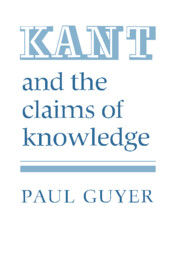Book contents
- Frontmatter
- Contents
- Acknowledgments
- Note on sources
- Introduction
- Part I Kant's early view
- Part II The transcendental deduction from 1781 to 1787
- Part III The principles of empirical knowledge
- 6 The schematism and system of principles
- 7 Axioms and anticipations
- 8 The general principle of the analogies
- 9 The first analogy: substance
- 10 The second analogy: causation
- 11 The third analogy: interaction
- Part IV The refutation of idealism
- Part V Transcendental idealism
- Afterword
- Notes
- Index of passages cited
- General index
10 - The second analogy: causation
Published online by Cambridge University Press: 09 March 2010
- Frontmatter
- Contents
- Acknowledgments
- Note on sources
- Introduction
- Part I Kant's early view
- Part II The transcendental deduction from 1781 to 1787
- Part III The principles of empirical knowledge
- 6 The schematism and system of principles
- 7 Axioms and anticipations
- 8 The general principle of the analogies
- 9 The first analogy: substance
- 10 The second analogy: causation
- 11 The third analogy: interaction
- Part IV The refutation of idealism
- Part V Transcendental idealism
- Afterword
- Notes
- Index of passages cited
- General index
Summary
The second analogy is the single argument intended both to replace the rationalists' fallacious derivation of the principle of sufficient reason from laws of logic alone and to refute Hume's skepticism that causal connections among distinct states of affairs can be known by human thought at all. Kant's rejection of a merely logical proof for the principle of sufficient reason was evident by the early 1760s, although even before then he had already pressed against Leibniz the argument that the principle entailed rather than precluded the genuine, causal action of one substance on another. Kant's obsession with Hume's attack on causation, of course, is manifest in his famous statement that it was this which first awoke him from his dogmatic slumber, and indeed that the Critique of Pure Reason itself was the result of nothing less than his attempt to put Hume's problem in its widest possible form (Prolegomena, 4:260–1). But the centrality of Hume's problem to Kant's thought is even more than usually evident in this passage from the Metaphysik Volckmann, which immediately precedes Kant's statement of the transcendental deduction in those revealing lectures:
Ratio realis is: quo posito ponitur aliud sed non secundum principium identitatis [A real ground is something which, when posited, something else must also be posited, but not according to the principle of identity], this relation of ground to consequence is therefore: si ponitur aliquid realiter diver sum [if something really distinct is also to be posited], but the logical ground is: quo ponitur aliquid logice, sed non realiter diver sum [that which is to be posited is logically but not really distinct]. […]
- Type
- Chapter
- Information
- Kant and the Claims of Knowledge , pp. 237 - 266Publisher: Cambridge University PressPrint publication year: 1987



